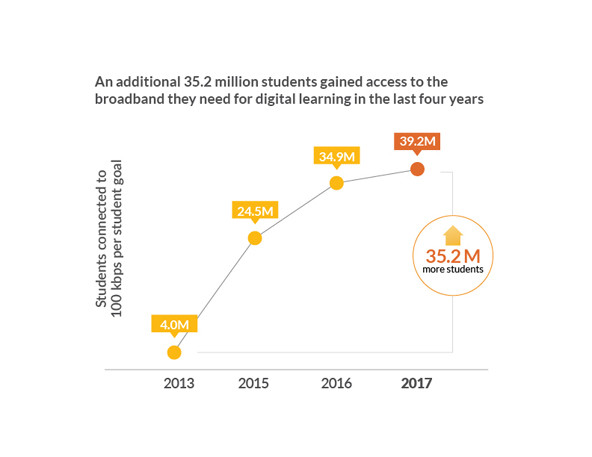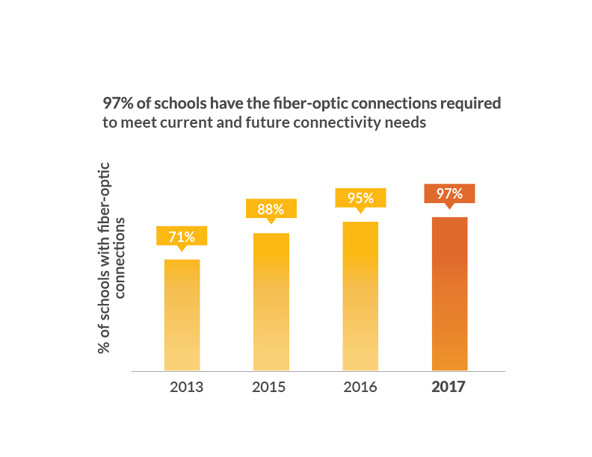As EducationSuperHighway began our journey to upgrade America’s K-12 schools, we learned early on that we needed two things to succeed. The first was significant early-stage funding, and the second was data. Why? Because early-stage organizations without sufficient capital and data lack the credibility and resources to challenge the system and lack the gravitas to be taken seriously about their solution. Data and money change that.
We learned this lesson the hard way. When we first tried to raise the problem of K-12 broadband infrastructure with federal policymakers in 2012, no one took us seriously. We were just another entity with an opinion—and no one was interested in listening. “There is no problem,” policymakers told us. “All our schools have broadband.” As an underfunded, five-person nonprofit in Silicon Valley, we had little chance of getting the federal government to pay attention to our opinion over the voices of the education policy establishment, and large telephone and cable companies.

However, critical, early, unrestricted funding allowed us the latitude to make strategic investments in data that catalyzed $12.5 billion of funding from the Federal Communications Commission to upgrade the broadband in our nation’s K-12 schools just two years later. As a result, more than 39 million students now have equal access to high-speed broadband and the educational opportunities presented by digital learning.
 (Chart courtesy of EducationSuperHighway)
(Chart courtesy of EducationSuperHighway)
We knew that data would amplify our voice and give us the credibility we needed to compete with the status quo. So, we set out to raise a war chest that would enable us to invest in building the first ever database detailing the state of broadband in America’s K-12 schools. Our message to these early-stage investors was: If we don't deliver, don't give us another dollar. This accountability, while counterintuitive and certainly scary to many early-stage entrepreneurs, was actually an important enabler of our success, as it forced us to be laser-focused on interim outcomes. It was a message that resonated with donors, and a year later, just 18 months into our mission, we had $10 million in funding.
We used this funding to create two databases that made EducationSuperHighway the most influential voice in K-12 broadband. First, we spent less than $250,000 to create a free Internet speed test for schools called the National SchoolSpeedTest, and spent a year recruiting 800,000 people in 35 percent of US schools to test their Internet speeds. This produced the first-ever data set on the state of broadband in America’s K-12 schools and gave us the data to prove there was a problem. In turn, this got the attention of policymakers in Washington D.C., and ultimately convinced the White House and Federal Communications Commission to help upgrade schools.
They did this by agreeing to modernize a $2.4 billion per year federal program called E-rate that was created in 1996 to connect the nation's schools and libraries to the Internet by paying 70 percent of the cost of their broadband. E-rate had succeeded in connecting America’s K-12 schools, but in the age of video and interactive digital learning, was failing to provide schools with the broadband capacity they needed. Indeed, the typical school had the same broadband as the average American home–despite having more than 100 times more users.
With policy change at hand, we used our funding to invest eight months and $1 million to build a second database—this one tracking how E-rate funds were being spent. While the traditional E-rate players (education advocacy groups and telephone companies) relied on opinions and relationships, our data won the fight for reform. Eighteen months later, the FCC adopted virtually all of our policy recommendations, resulting in an expanded $3.9 billion per year E-rate program that was now positioned to accelerate K-12 broadband upgrades. In essence, the combination of early, unrestricted funding that gave us the flexibility to invest in data at critical moments had enabled us to change the policy landscape.
Unlocking these federal dollars was critical, but it was only a part of the solution. To make any real progress, we also needed to show governors where the problem existed in their states. Once again, we turned to data. We showed governors exactly which school districts in their states needed upgrades, making it clear that the problem was both finite and solvable. As a result, in less than two years, 46 governors publicly committed to making K-12 broadband upgrades a priority—providing both a powerful channel for reaching school districts in need and more than $200 million in funding for fiber and wi-fi deployments.
Our data also revealed something even more important: huge variances in both the cost and speed of broadband, often among schools just a few miles apart. We created visual data maps that showed districts what schools were paying and what speed they were getting. This enabled them to negotiate more effectively with service providers and, as a result, costs went down an average of 78 percent, and we tripled the number of schools with enough Internet access for digital learning in four years.
When we started our work, less than 10 percent of America’s K-12 public school students and teachers had the broadband they needed to leverage technology in the classroom. Four years later, we have upgraded more than 35 million kids, and 94 percent of public school districts have high-speed broadband. We have also brought fiber optic connections to 97 percent of schools, more than tripled the number of classrooms with wi-fi, and cut the cost of broadband for schools by nearly 80 percent.
 (Chart courtesy of EducationSuperHighway)
(Chart courtesy of EducationSuperHighway)
EducationSuperHighway was able to bring innovations to the sector because of strong early-stage funding. Too many donors fail to provide enough capital upfront to enable early-stage organizations the flexibility to make game-changing strategic investments. They fund just enough to keep the lights on, but not enough to support the core activities social entrepreneurs need to establish their organizations as leaders in their sector. Having sufficient capital at the beginning enabled us to make critical investments to dramatically shift the system—investments that would have been impossible to make if we had lowered our sights and raised only $250,000. Another lesson? It can be as hard to raise $250,000 as it is to raise $10 million–we just had to have the courage to ask for what we needed to really catalyze change.
Though nearly impossible for anyone to see at the time, the difference between connecting 35 million students in four years and connecting no one, was the early investment of $10 million and our obsession with data. We were tempted to ask for less and spend less, but that would have left us without the ability to make the strategic investments that powered our impact. The urgency of now requires boldness on the part of funders and entrepreneurs to step up to the challenges of the day. Make the ask, and make real change.
Support SSIR’s coverage of cross-sector solutions to global challenges.
Help us further the reach of innovative ideas. Donate today.
Read more stories by Evan Marwell.

